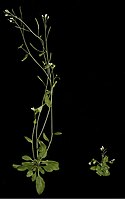
Photo from wikipedia
Heavy metals, including a hexavalent form of chromium (Cr(VI)) increasing accumulation in agricultural soil, cause a significant reduction in quality, yield, and growth of rice varieties worldwide. Screening for the… Click to show full abstract
Heavy metals, including a hexavalent form of chromium (Cr(VI)) increasing accumulation in agricultural soil, cause a significant reduction in quality, yield, and growth of rice varieties worldwide. Screening for the selection of tolerant varieties is essential for conventional and molecular breeding. Shaheen basmati (SB) and basmati-385 (B-385) rice varieties, a subspecies of indica, show different sensitivity to Cr(VI), but the underlying mechanisms of this different sensitivity remain elusive. In the current study, we examine the sensitivity of SB and B-385 based on the root, which is the primary organ that encounters water and soil containing Cr(VI), elongation assay, and ethylene’s possible role (a stress-responsive phytohormone) in the process. Our results show that SB’s seedlings exhibit hypersensitivity as a higher root elongation inhibition than B-385 under different Cr(VI) concentrations. Hypersensitive SB consistently expresses a higher level of ethylene biosynthesis and signaling-related genes than B-385. Moreover, ethylene signaling antagonist (silver, Ag) and biosynthesis inhibitor (aminoethoxy vinyl glycine, AVG) alleviate the difference in Cr(VI)-induced root growth inhibition between SB and B-385, respectively. Taken together, we conclude that ethylene mediates difference in sensitivity based on the difference in root growth inhibition in different rice varieties. The difference in Cr(VI)-induced root growth inhibition in SB and B-385. (A) Root growth of SB is slightly more as compared to B-385 in control conditions in the Hoagland solutions. (B) Seedlings of SB showed hypersensitivity to 200 μM Cr(VI) compared to B-385 in terms of primary root growth inhibition, which was higher in SB than B-385. Interestingly, Cr(VI)-induced relative transcript level of ethylene biosynthesis, perception, and signaling-related genes was significantly higher in hypersensitive SB than B-385. Current results in association with previous literature show that Cr(VI)-induced ethylene biosynthesis is regulating Cr(VI)-induced ethylene perception, signaling, and associated Cr(VI)-induced ethylene-mediated primary root growth inhibition. Conclusively, the difference in ethylene quantities in both varieties mediates the difference in root growth inhibition between SB and B-385 (C and E). The difference in Cr(VI)-induce root growth inhibition between SB and B-385 was significantly alleviated by ethylene signaling inhibitor (10 μM Ag, as AgNO3) and ethylene biosynthesis inhibitor (10 μM AVG) treatment in the presence of 200 μM Cr(VI), respectively. (D) Ethylene biosynthesis precursor (10 μM ACC) treatment-mediated induced root growth inhibition difference between SB and B-385 was not significant, which may be because of enough quantity of the Cr(VI)-mediated ethylene accumulation or unknown limiting factor. Arrows mean addition and an increase in expression, and T-line means suppression or inhibition. The width of the pointers (arrows) is proportional to the gene expression level. The difference in Cr(VI)-induced root growth inhibition in SB and B-385. (A) Root growth of SB is slightly more as compared to B-385 in control conditions in the Hoagland solutions. (B) Seedlings of SB showed hypersensitivity to 200 μM Cr(VI) compared to B-385 in terms of primary root growth inhibition, which was higher in SB than B-385. Interestingly, Cr(VI)-induced relative transcript level of ethylene biosynthesis, perception, and signaling-related genes was significantly higher in hypersensitive SB than B-385. Current results in association with previous literature show that Cr(VI)-induced ethylene biosynthesis is regulating Cr(VI)-induced ethylene perception, signaling, and associated Cr(VI)-induced ethylene-mediated primary root growth inhibition. Conclusively, the difference in ethylene quantities in both varieties mediates the difference in root growth inhibition between SB and B-385 (C and E). The difference in Cr(VI)-induce root growth inhibition between SB and B-385 was significantly alleviated by ethylene signaling inhibitor (10 μM Ag, as AgNO3) and ethylene biosynthesis inhibitor (10 μM AVG) treatment in the presence of 200 μM Cr(VI), respectively. (D) Ethylene biosynthesis precursor (10 μM ACC) treatment-mediated induced root growth inhibition difference between SB and B-385 was not significant, which may be because of enough quantity of the Cr(VI)-mediated ethylene accumulation or unknown limiting factor. Arrows mean addition and an increase in expression, and T-line means suppression or inhibition. The width of the pointers (arrows) is proportional to the gene expression level.
Journal Title: Environmental Science and Pollution Research
Year Published: 2021
Link to full text (if available)
Share on Social Media: Sign Up to like & get
recommendations!